 |
 |
 |
| |
Liver Disease Progression in Chronic Hepatitis B Infected Persons With Persistently Normal Serum Alanine Aminotransferase Level: Update From the R.E.V.E.A.L.-HBV Study
|
| |
| |
Reported by Jules Levin
43rd EASL
April 23-27, 2008
Milan, Italy
Jin-De Chen, M.D.1, Hwai-I Yang, Ph.D. 2, Uchenna H. Iloeje, M.D.3, San-Lin You, Ph.D. 2, Sheng-Nan Lu, M.D. Ph.D.4, Li-Yu Wang, Ph.D.5, Jun Su, M.D.3, Chien-An Sun, Sc.D.6, Pei-Jer Chen, M.D. Ph.D.7, Yun-Fan Liaw, M.D.8, Chien-Jen Chen, Sc.D.2 for the R.E.V.E.A.L.-HBV Study Group
1Department of Internal Medicine, Bei-Hu Branch, National Taiwan University Hospital, Taipei, Taiwan; 2Genomics Research Center, Academia Sinica, Taipei, Taiwan; 3Research and Development, Bristol-Myers Squibb Co., Wallingford, CT, USA; 4Department of Gastroenterology, Kaohsiung Chang-Gung Memorial Hospital, Kaohsiung, Taiwan; 5Department of Public Health, Tzu Chi University, Hualien, Taiwan; 6School of Public Health, National Defense Medical Center, Taipei, Taiwan; 7Graduate Institute of Clinical Medicine, National Taiwan University College of Medicine, Taipei, Taiwan; 8Liver Research Unit, Chang Gung Memorial Hospital and Chang Gung University, Taipei, Taiwan
A subset of 2,097 participants chronically infected with HBV from the R.E.V.E.A.L.-HBV study cohort recruited and invited at least annually for regular follow-up with ultrasonography and serological tests until June 30, 2004 was used in this study
Initial disease states: all participants in this analysis were HBsAg(+) with normal ALT by two or more consecutive tests and no evidence of cirrhosis or HCC in the first year of study entry. They were classified into three groups:
1) HBeAg(-) with HBV DNA <104 copies/mL (Group1)
2) HBeAg(-) with HBV DNA >104 copies/mL (Group 2)
3) HBeAg(+) with HBV DNA >104 copies/mL (Group 3)
AUTHOR SUMMARY
The probabilities of disease state transition were much higher in subjects with HBV DNA >104 copies/mL (10,000 copies/ml) compared with those who were HBeAg(-) and HBV DNA <104 copies/mL
Serum HBV DNA level at enrolment was a universal independent risk predictor for progression from asymptomatic chronic HBV infection to a different subsequent disease state
HBeAg seropositivity and HBV genotype C were independent risk predictors for liver cirrhosis only
The intermediate liver disease states in the natural history of CHB were major predictors of liver disease progression
AUTHOR CONCLUSION
Probabilities of disease-state transition were estimated using this population based prospective study, especially for those who were HBeAg(-), had HBV DNA <104 copies/mL and a persistently normal ALT level during the first year of
enrolment
Elevated baseline HBV DNA level is an important risk predictor for disease states transition in CHB
Subjects who are HBeAg(+) with HBV DNA >104 copies/mL are at increased risk of developing chronic hepatitis (elevation of ALT) and end-stage liver diseases such as liver cirrhosis, HCC and death
ABSTRACT
Background and Aims
There are few population-based long-term follow-up studies on natural history and risk factors for disease progression of chronic hepatitis B (CHB) virus infection with persistently normal serum alanine aminotransferase (ALT) levels.
Methods
A subset of the R.E.V.E.A.L.-HBV cohort (n=2,097) with persistently normal serum ALT level for the first year of cohort enrollment, and free from liver cirrhosis and hepatocellular carcinoma (HCC) were included in these analyses. Serum samples collected at study entry were tested for HBeAg, serum HBV DNA level, and HBV genotype. New events of CHB (subsequent persistent or intermittent ALT elevation), liver cirrhosis (LC), HCC, and liver-related death (LD) were ascertained through follow-up serum ALT levels, abdominal ultrasonography, and data-linkage with computerized National Cancer Registry and Death Certification profiles. The sequential progression from one health state to the subsequent liver disease states and multivariate-adjusted hazard ratios of risk predictors were estimated stratified by baseline HBV DNA level (10^4 copies/mL). Both baseline characteristics and time-dependent intermediate disease states were included in the Cox regression models.
Results
A total of 2,097 subjects contributed 27,282 person-years of follow-up (mean duration 12.5 years using death as the final outcome), and 292, 109, 44, and 28 new cases of CHB, LC, HCC, and LD, respectively.
For HBeAg-seropositive subjects with baseline HBV DNA >=10^4 copies/mL, the sequential incidence rates (per 100,000 person-years) from asymptomatic carriers through CHB, LC, HCC, and LD were 3,089, 3,265, 3,005, and 24,933, respectively. Comparable figures for HBeAg-seronegative subjects with HBV DNA >=10^4 (<10^4 ) copies/mL were 2,017 (842), 2,728 (912), 3,928 (2,826), and 14,548 (5,932) per 100,000 person-years.
Elevated serum HBV DNA levels, independent of HBeAg and intermediate disease state, increased the risk of disease progression throughout the natural history of CHB.
Genotype C hepatitis B virus predominated in asymptomatic carriers with active viral replication (HBeAg-seropositive and serum HBV DNA =10^4 copies/mL) and contributed to increased risk of liver cirrhosis with a hazard ratio of 1.7 (1.1-2.7).
Conclusions
Among other risk factors, elevated serum level of HBV DNA is an important risk predictor for disease-state transition in CHB.
Introduction
Clinical spectrums of chronic hepatitis B virus (HBV) infection include progressive states of chronic hepatitis, liver cirrhosis and hepatocellular carcinoma (HCC)
Most individuals with chronic HBV infection are asymptomatic, with a normal serum level of alanine aminotransferase (ALT)
Clinical guidelines define the inactive chronic HBV infection state as the seronegative status of hepatitis B e antigen (HBeAg), HBV DNA <104 copies/mL and a persistently normal ALT level.1 The natural history of inactive chronic HBV infection has not been extensively studied
This study aimed to analyse the progression of liver disease state and its risk predictors for hepatitis B surface antigen (HBsAg) positive participants with persistently normal serum ALT levels and without liver cirrhosis and HCC for the first year after enrollment
Materials and Methods
A subset of 2,097 participants chronically infected with HBV from the R.E.V.E.A.L.-HBV study cohort recruited and invited at least annually for regular follow-up with ultrasonography and serological tests until June 30, 2004 was used in this study
The participants in this study had not received any antiviral treatment
Exclusion criteria:
- no adequate serum samples for HBeAg or HBV DNA tests at entry
- do not have persistently normal serum ALT levels (<45 U/L) for the first year of enrolment
- no abdominal ultrasonography at study entry or follow-up examinations
- lost to follow-up for more than 1 year before the ascertainment of major adverse events (cirrhosis, HCC or liver-related death)
Initial disease states: all participants in this analysis were HBsAg(+) with normal ALT by two or more consecutive tests and no evidence of cirrhosis or HCC in the first year of study entry. They were classified into three groups:
1) HBeAg(-) with HBV DNA <104 copies/mL (Group1)
2) HBeAg(-) with HBV DNA >104 copies/mL (Group 2)
3) HBeAg(+) with HBV DNA >104 copies/mL (Group 3)
Definition of incident disease state (date of first detection was used as the date of transition)
- Chronic hepatitis: persistent or intermittent abnormal ALT (> 45 U/L)
- Liver cirrhosis: at least two consecutive diagnoses of cirrhosis based on abdominal ultrasonography
- HCC: based on histopathological examination, imaging techniques and serum
_-fetoprotein with detection by follow-up examination and data linkage with National Cancer Registry of Taiwan
- Liver-related death: Codes of International Classification of Disease of 070.2, 070.3, 155, 570, 571, 572 and 573 obtained through data linkage with National Death Certification profile
Statistical analyses
- The person-years of follow-up between two consecutive disease states were calculated from the date at the study entry or the onset of initial disease state to the date at the onset of subsequent disease state, death or last follow-up date (June 30, 2004), whichever came first
- The cumulative hazard of each disease state by follow-up year was derived by the Nelson-Aalen method
- Cox proportional hazard regression models containing both baseline characteristics and time-dependent intermediate disease states were used to analyse their associations with the risk of progression from one disease state to another
RESULTS
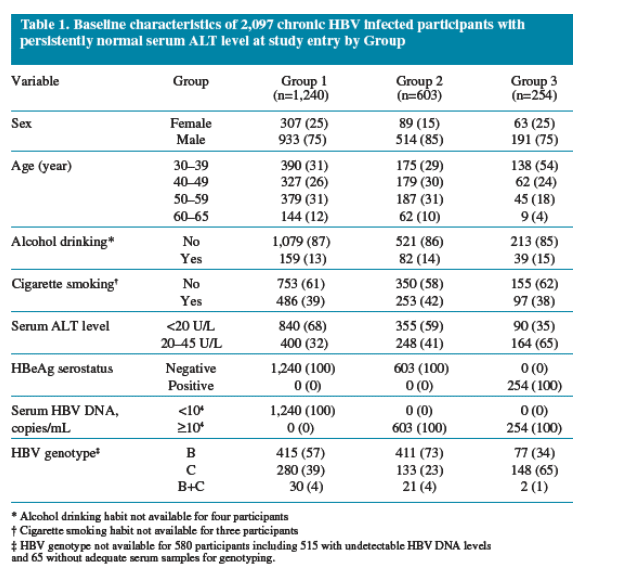
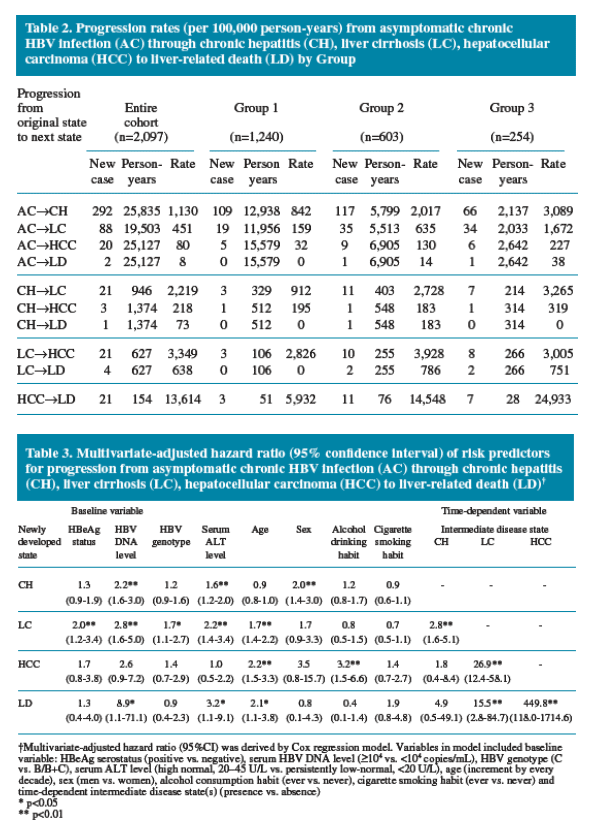
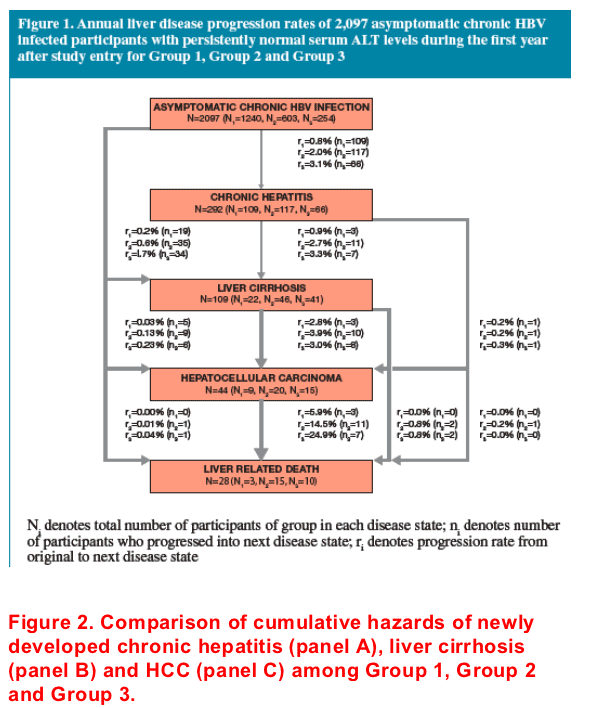
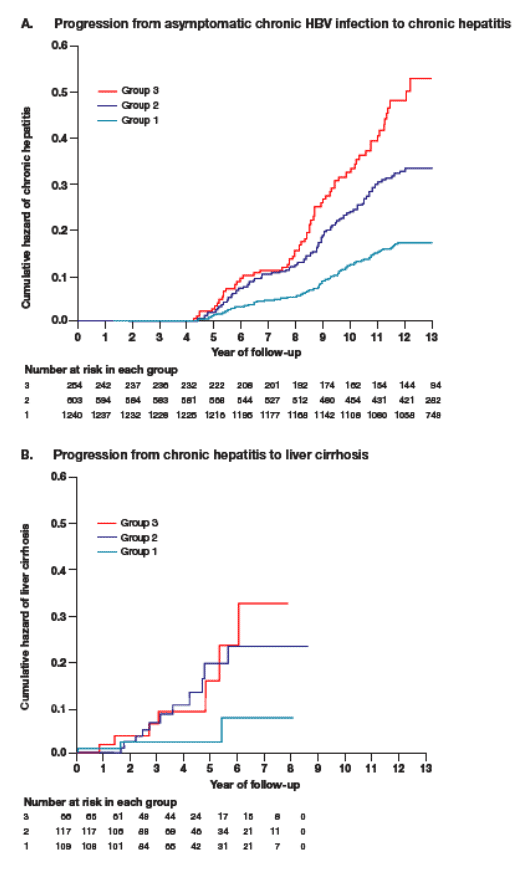
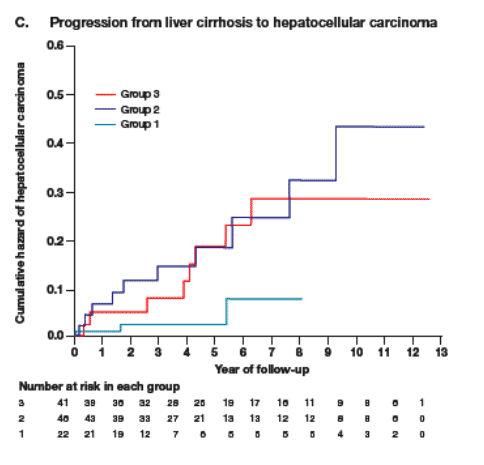
|
| |
|
 |
 |
|
|